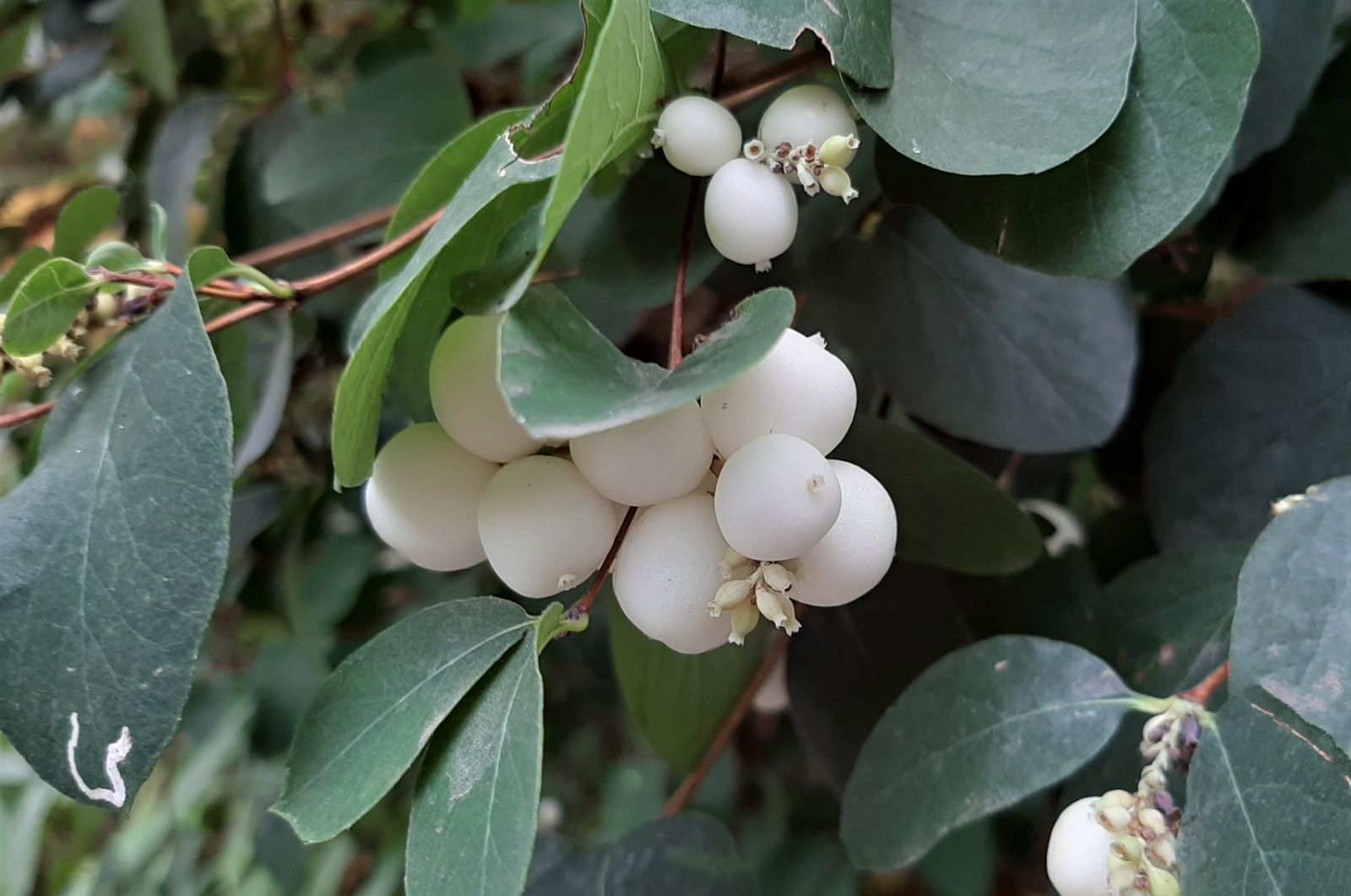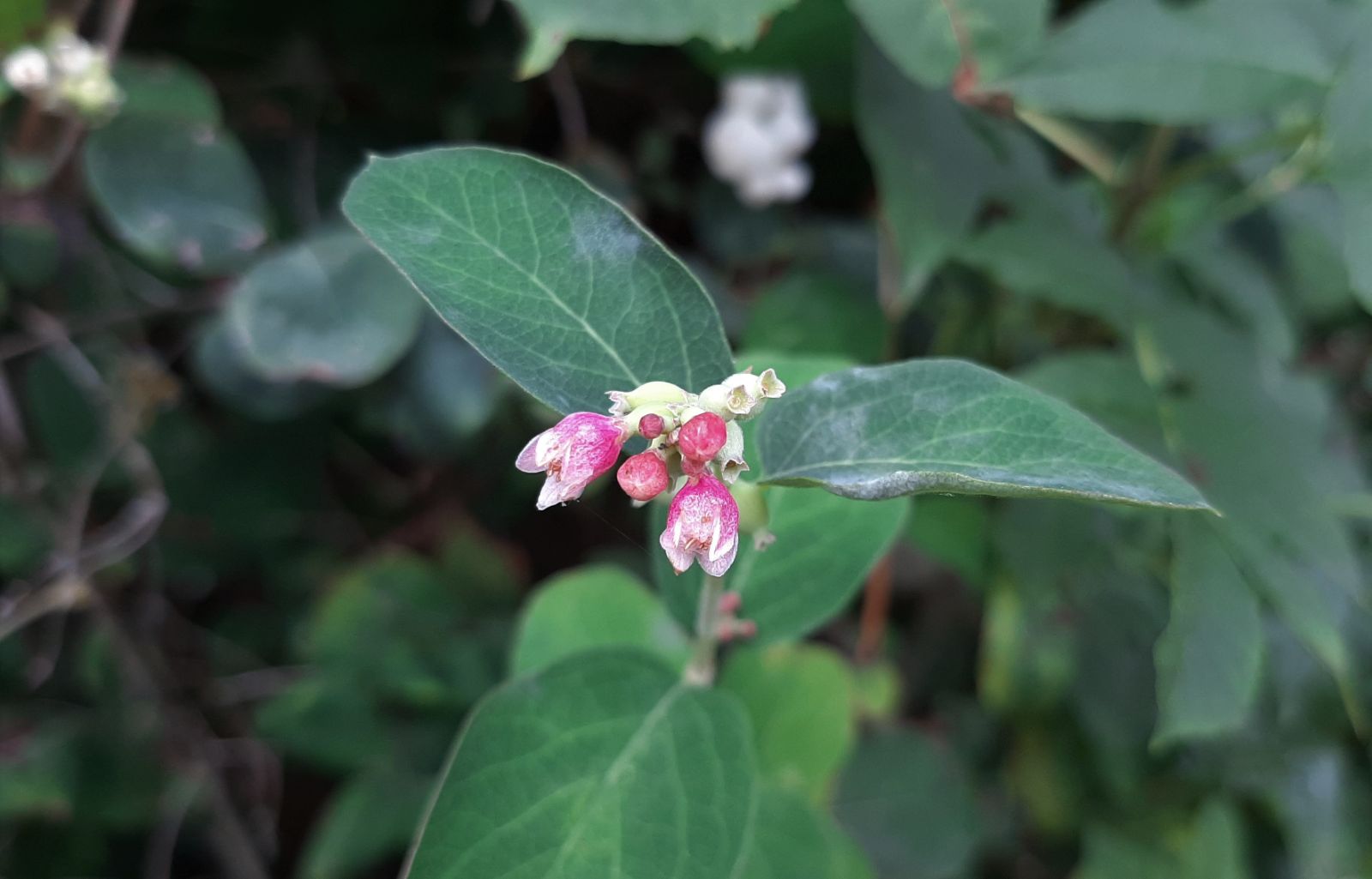Symphoricarpos
Sponsor
Kindly sponsored by
The Normanby Charitable Trust
Credits
Owen Johnson (2021)
Recommended citation
Johnson, O. (2021), 'Symphoricarpos' from the website Trees and Shrubs Online (treesandshrubsonline.
Family
- Caprifoliaceae
Common Names
- Snowberry
Species in genus
- Symphoricarpos acutus
- Symphoricarpos albus
- Symphoricarpos × chenaultii
- Symphoricarpos Doorenbos Group
- Symphoricarpos guadalupensis
- Symphoricarpos guatemalensis
- Symphoricarpos hesperius
- Symphoricarpos longiflorus
- Symphoricarpos microphyllus
- Symphoricarpos mollis
- Symphoricarpos occidentalis
- Symphoricarpos orbiculatus
- Symphoricarpos oreophilus
- Symphoricarpos palmeri
- Symphoricarpos parishii
- Symphoricarpos rotundifolius
- Symphoricarpos sinensis
- Symphoricarpos 'Snow White'
About 15 species of deciduous shrub, trailing, spreading or thicket-forming; one Chinese, the others from North America. Twigs grey-brown, hollow, the older bark often shredding. Buds opposite, tiny, with several pairs of scales. Leaves ovate, 0.5–11 cm long, entire or irregularly lobed/toothed, short-stalked and lacking stipules. Flowers forming a dense spike tipping lateral branches, or solitary in the axils of the upper leaves. Calyx cupular, with 4 or 5 lobes. Corolla more or less regular, pinkish-red or white, bell-shaped to fuse-shaped, with 4 or 5 lobes. Stamens 4 or 5, inserted in corolla tube. Ovary with 4 locules, 2 of the locules with several sterile ovules, the other 2 each with 1 fertile ovule. Fruit a berrylike drupe, carried singly or in small compact clusters, white to purplish red or blue-black, globose to ellipsoid; 2 pyrenes per fruit. (Jones 1940; Flora of China 2021).
This small genus of shrubs attracts the interest of gardeners almost exclusively for its autumn fruits, which are most often a brilliant pearly-white; they are likely to be described as berries but in botanical terminology are drupes, since their flesh envelops the paired central nutlets. These drupes are sometimes carried in small, congested clusters, each cluster consisting of fruit varying remarkably in size, and slightly in shape; the generic name (from the classical Greek symporein and karpos, ‘fruit carried together’) was published by J.J. Dillen (Dillenius) in Hortus Elthamensis in 1732 (Bean 1981), for the plant now called Symphoricarpos orbiculatus, being validated nomenclaturally by Duhamel du Monceau in 1753 (Jones 1940). Duhamel understood Symphoricarpos to be a female noun, but botanical convention has since accepted it as male.
The ‘snowberries’ themselves are toxic, though the poisonous saponins are not readily digested by humans (Plants for a Future 2021); the crushed fruit of Symphoricarpos albus was used by native American tribes to poison and incapacitate fish (Plants for a Future 2021). In European gardens at least, the fruit are usually rejected by birds until late in winter (Hoffman 2012). The pink (rarely white) flowers are small, and in the widely-cultivated forms are too much hidden among the summer foliage to be showy, while the colour-contrast of pink and dull green is not particularly effective; they can however provide an important nectar source for bees and hoverflies (Hoffman 2012), and bumblebees are most species’ main pollinators. The leaves tend to a plain oval shape, though they sometimes show wavy margins, odd teeth or deep, random lobes, especially on vigorous young extension growth, much like those of the quite closely related European honeysuckle Lonicera peryclymenum; they seldom colour brightly in autumn, though S. orbiculatus in its native south-eastern United States turns dark crimson and several low-growing forms from the Rocky Mountains go yellow. The smaller-leaved species are generally more attractive as foliage plants, including the Mexican S. microphyllus, which has donated its genes to the garden hybrids S. × chenaultii and to parts of the Doorenbos Group. In winter, Snowberries are typically dismissed as scruffy, twiggy, dull grey-brown plants; however, since they flower from the new wood, they can be ‘tidied’ by hard pruning in March (Edwards & Marshall 2019).
The widely cultivated Snowberry forms are among the toughest of garden plants, able to cope with intense winter cold, summer drought, waterlogging, poor soils (whatever the pH), dense shade and urban pollution; they are sometimes used in Holland to protect against soil erosion (Hoffman 2012). In warm dry summers they can suffer from powdery mildew (mostly Podosphaera cladestrina), and are also variously subject to leaf-spot fungi (primarily Sphaceloma symphoricarpi), but such infections are unsightly rather than life-threatening (Hoffman 2012). Snowberries are easily propagated by cuttings, or by division (Bean 1981); the thicket-forming species – which include all the common garden variants – also layer naturally.
Until the mid 20th century the common Snowberry in European gardens was Symphoricarpos albus subsp. laevigatus, from north-western parts of North America; this is one of the tallest-growing forms (to 3 m) and has much the largest fruit (to c. 18 mm wide), which are clustered and usually pure white. This taxon is now widely naturalised in north-western Europe; though it does not spread aggressively enough to be of major conservation concern, it can still be difficult to erradicate on a local scale, especially where it has outgrown its welcome in old established gardens or naturalised in woods where it has been planted for game cover. Colour was introduced to the Snowberries’ fruiting display with the cultivation of the primarily Mexican S. microphyllus, whose drupes can be flushed pink, and the American S. orbiculatus, which bears purplish red fruit; these species hybridised, probably in France towards the start of the 20th century, to produce S. × chenaultii, whose fruits are variously red and pink. Over the last century, the breeding of new Snowberry cultivars has been most active in Holland, where Simeon Doorenbos began in 1935 to attempt to cross S. × chenaultii with S. albus subsp. laevigatus with the aim of producing pink-fruiting, white-fruiting and groundcover plants, many of which have become especially important to the cut-flower industry. Thirty-two such clones are now represented in two collections at the Boot and Dart Nurseries at Boskoop (on peat) and Leersum (on sand) (Hoffman 2012).
The single Chinese representative of the genus, Symphoricarpos sinensis, was introduced to the west by Ernest Wilson in 1911–12, and is unique in its blue-bloomed black fruit; it has not persisted in cultivation in Europe or America. S. guatemalensis, endemic to mountains in western Guatemala, was described in 1994 and was introduced to cultivation in the UK ten years later. The remaining species, as understood here – S. acutus, S. guadelupensis, S. hesperius, S. longiflorus, S. mollis, S. occidentalis, S. oreophilus, S. palmeri, S. parishii and S. rotundifolius – are indigenous to temperate North America, often in dry and harsh environments, and are scarcely known as garden plants even in their native United States, though S. ‘Snow White’ was raised in Holland in 2013 from seed purportedly collected from S. rotundifolius.
The definitive monograph on Symphoricarpos was written as long ago as 1940 by G. Neville Jones (Jones 1940). As a clearly-defined but rather minor group of plants, this genus has not yet been subjected to the intensive phylogenetic analyses which have clarified the evolutionary position of many of its allies in Caprifoliaceae. Genetic markers in specimens representing 11 taxa were studied in 2010 by Charles Bell (Bell 2010), who found, as expected, that Symphoricarpos represents a single, genetically distinct group and that the Chinense S. sinensis is related more distantly to the commoner American taxa than any of these are to each other. Bell’s work, however, has not yet cast much light on the issue of which, among the more minor North American forms, should be considered good species and which are variants of other species. As a result Jones’ classification, based on gross morphological features, remains central to our understanding of this group, though one additional species (S. guadalupensis, endemic to western Texas) was described as recently as 1968, and a few kinds from the western United States which were treated by Jones as species (S. tetonensis, S. vaccinioides and S. utahensis) are understood by most contemporary botanists to be synonymous with S. rotundifolius or S. oreophilus.
Simply for convenience, and not to advance a taxonomic opinion, this account in general follows the nomenclature recommended by Plants of the World Online (Plants of the World Online 2021), but also treats as good species two taxa (S. oreophilus and S. palmeri) which are accepted by many American botanists, including Bell, who analysised parts of their genome in his 2010 study (Bell 2010). This account also departs from the treatment of the genus in Plants of the World Online by defining the distinctive and horticulturally important form laevigatus as a subspecies, rather than a variety, of S. albus. However it seems highly likely that further and more detailed genetic analyses will favour a few modifications to this classification.
Identification key | ||
| 1a | Fruit black with a bluish bloom; Chinese species: | Symphoricarpos sinensis |
| 1b | North American species or hybrids; fruit white, pinkish or purplish-red: | 2 |
| 2a | Leaves to 6 mm long; endemic to Guatemala: | S. guatemalensis |
| 2b | Leaves 7–110 mm long: | 3 |
| 3a | Fruit clear pink to red or purplish: | 4 |
| 3b | Fruit white, or pink-flushed on the sunny side: | 5 |
| 4a | Leaves thick, dull green, 10–60 mm long; fruit purplish-red; wild species from the central United States: | S. orbiculatus |
| 4b | Leaves flimsy, often less than 30 mm long; cultivated plants: | S. × chenaultii; S. Doorenbos Group |
| 5a | Corolla bell-shaped, with lobes about as long as the tube: | 6 |
| 5b | Corolla narrow, tubular; lobes much shorter than the tube, style shorter than corolla: | 12 |
| 6a | Leaf large (30–110 mm) and thick; style 4–8 mm long; style and stamens projecting slightly beyond the corolla: | S. occidentalis |
| 6b | Style 2–3 mm; style and stamens shorter than or equally the corolla: | 7 |
| 7a | Corolla 5–8 mm long, nutlets 4–6 mm long: | 8 |
| 7b | Corolla 3–5 mm, nutlets 2.5–3 mm long: | 9 |
| 8a | Shrub to 1 tall; shoot and leaf finely downy; fruit to 10 mm wide, paired or single: | S. albus |
| 8b | Shrub to 3 m; shoot and leaf mostly glabrous; fruit to 18 mm wide, in small dense clusters: | S. albus subsp. laevigatus; S. Doorenbos Group |
| 9a | Erect shrub endemic to western Texas; shoot and leaf glabrous: | S. guadalupensis |
| 9b | Diffuse or trailing plant, variably pubescent: | 10 |
| 10a | Shoots velvety, with straight hairs; leaves pubescent on both sides: | S. acutus |
| 10b | Shoots with short curved hairs: | 11 |
| 11a | Leaves firm, with rounded tips; shoots usually densely hairy: | S. mollis |
| 11b | Leaves thin, usually pointed, nearly hairless above; shoots sparsely hairy: | S. hesperius |
| 12a | Corolla a slender tube, with one small basal nectary; leaves glaucous, 2–5 mm wide; endemic to dry mountainsides in the south-western United States: | S. longiflorus |
| 12b | Corolla a broader tube with five basal nectaries | 13 |
| 13a | Bush to 3 tall; older bark smoothish; anthers as long or longer than corolla lobes; leaves pointed: | S. microphyllus |
| 13b | Anthers shorter than corolla-lobes: | 14 |
| 14a | Low, spreading plant rooting from the branch-tips; leaves glaucous; corolla 6–7 mm long: | S. parishii |
| 14b | Erect or trailing plant; corolla (5–)8–13 mm long: | 15 |
| 15a | Foliage and shoot more or less glabrous; corolla 11–13 mm long: | S. oreophilus |
| 15b | Foliage and shoot pubescent; corolla 5–9 mm long: | 16 |
| 16a | Trailing shrub; leaves paler beneath; petiole 1–2 mm long: | S. palmeri |
| 16b | A more upright shrub; leaves scarcely paler beneath; petiole to 4 mm long: | S. rotundifolius |


